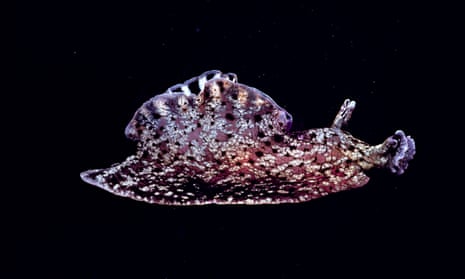Science may never know what wistful memories play on the mind of the California sea hare, a foot-long hermaphrodite marine snail, as it munches on algae in the shallow tide pools of the Pacific coast.
But in a new study, researchers claim to have made headway in understanding the simplest kind of memory a mollusc might form, and, with a swift injection, managed to transfer such a memory from one sea snail to another.
David Glanzman, a neurobiologist at the University of California in Los Angeles, believes the kinds of memories that trigger a defensive reflex in the snail are encoded not in the connections between brain cells, as many scientists would argue, but in RNA molecules that form part of an organism’s genetic machinery.
In an experiment to test the idea, Glanzman implanted wires into the tails of California sea hares, or Aplysia californica, and gave them a series of electric shocks. The procedure sensitised the animals so that when they were prodded in a fleshy spout called a siphon, they contracted their gills in a robust defensive action. Glanzman likens the reaction to being jumpy in the moments after an earthquake: the memory of the event induces an involuntary reflex to any loud noise.
After sensitising the sea snails, Glanzman extracted RNA from the animals and injected it into other sea snails to see what happened. He found the recipient sea snails became sensitised, suggesting the “memory” of the electrical shocks had been transplanted. When Glanzman repeated the experiment with RNA from sea snails that had been hooked up to wires but not shocked, the reflex behaviour did not transfer.
According to the researchers, the experiments show how essential parts of the memory trace, or engram, that gives rise to sea hare sensitisation are held in RNA, rather than in the connectivity of brain cells as traditional neuroscience dictates.
“What we are talking about are very specific kinds of memories, not the sort that says what happened to me on my fifth birthday, or who is the president of the United States,” said Glanzman, whose study appears in the journal eNeuro.
The work has not found widespread acceptance. “Obviously further work needs to be carried out to determine whether these changes are robust and what are the underlying mechanisms,” said Prof Seralynne Vann, who studies memory at Cardiff University. “While the Aplysia is a fantastic model for studying basic neuroscience, we must be very careful in drawing comparisons to human memory processes, which are much more complex.”
Tomás Ryan, who studies memory at Trinity College Dublin, is firmly unconvinced. “It’s interesting, but I don’t think they’ve transferred a memory,” he said. “This work tells me that maybe the most basic behavioural responses involve some kind of switch in the animal and there is something in the soup that Glanzman extracts that is hitting that switch.”
But Ryan added that radical thinking about memory was sorely needed: “In a field like this which is so full of dogma, where we are waiting for people to retire so we can move on, we need as many new ideas as possible. This work takes us down an interesting road, but I have a huge amount of scepticism about it.”
